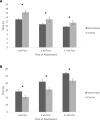Pelvic floor muscle training in radical prostatectomy: a randomized controlled trial of the impacts on pelvic floor muscle function and urinary incontinence
- PMID: 31729959
- PMCID: PMC6858748
- DOI: 10.1186/s12894-019-0546-5
Pelvic floor muscle training in radical prostatectomy: a randomized controlled trial of the impacts on pelvic floor muscle function and urinary incontinence
Abstract
Background: Pelvic floor muscle training (PFM) training for post-prostatectomy incontinence (PPI) is an important rehabilitative approach, but the evidence base is still evolving. We developed a novel PFM training program focussed on activating fast and slow twitch muscle fibres. We hypothesized that this training, which commenced pre-operatively, would improve PFM function and reduce PPI, when compared to a control group.
Methods: This randomized trial allocated 97 men (63 ± 7y, BMI = 25.4, Gleason 7) undergoing radical prostatectomy (RP) to either a control group (n = 47) performing low-volume rehabilitation, or an intervention group (n = 50). Both interventions commenced 5 weeks prior to surgery and continued for 12 weeks post-RP. Participants were assessed pre-operatively and at 2, 6 and 12 weeks post-RP using 24 h pad weights, International Prostate Symptom Score (IPSS), Expanded Prostate Cancer Index Composite for Clinical Practice (EPIC-CP) and real time ultrasound (RTUS) measurements of PFM function.
Results: Following RP, participants in the control group demonstrated a slower return to continence and experienced significantly more leakage (p < 0.05), measured by 24 h pad weight, compared to the intervention group, suggesting an impact of the prehabilitation protocol. PFM function measures were enhanced following RP in the intervention group. Secondary measures (IPSS, EPIC-CP and RTUS PFM function tests) demonstrated improvement across all time points, with the intervention group displaying consistently lower "bothersome" scores.
Conclusions: A pelvic floor muscle exercise program commenced prior to prostate surgery enhanced post-surgical measures of pelvic floor muscle function, reduced PPI and improved QoL outcomes related to incontinence.
Trial registration: The trial was registered in the Australia New Zealand Clinical Trials Registry and allocated as ACTRN12617001400358. The trial was registered on 4/10/2017 and this was a retrospective registration.
Keywords: Men’s health; Pelvic floor muscle; Prostatectomy; Quality of life; Urinary incontinence.
Conflict of interest statement
The authors declare that they have no competing interests.
There are no potential conflicts of interest in the submitted research and all participants provided informed consent prior to inclusion in the study. This research involved human participants, however none were exposed to any potential harm, as all assessments made were either by questionnaire or non-invasive real time ultrasound approaches.
Figures



Comment in
-
Re: Pelvic Floor Muscle Training in Radical Prostatectomy: A Randomized Controlled Trial of the Impacts on Pelvic Floor Muscle Function and Urinary Incontinence.J Urol. 2020 Jul;204(1):191. doi: 10.1097/JU.0000000000001059.03. Epub 2020 Apr 15. J Urol. 2020. PMID: 32293965 No abstract available.
References
-
- www.globocan.iarc.fr. Prostate cancer: estimated incidence: mortality and prevelance worldwide in 2012. 2018. https://www.iarc.fr/en/media-centre/pr/2018/pdfs/pr263_E.pdf. Accessed 8 Aug 2018.
-
- Shikanov S. Urinary and sexuality QOL 1 year following RARP. J Urol. 2008;180(2):760–66. - PubMed
-
- Shikanov SA. A prospective report of changes in prostate cancer related quality of life after robotic prostatectomy. J Psych Oncol. 2011;29:1157–67. - PubMed
-
- www.ics.org. https://www.ics.org/terminology/580. 2018. Accessed 8 Aug 2019.
Publication types
MeSH terms
LinkOut - more resources
Full Text Sources
Medical
Miscellaneous

